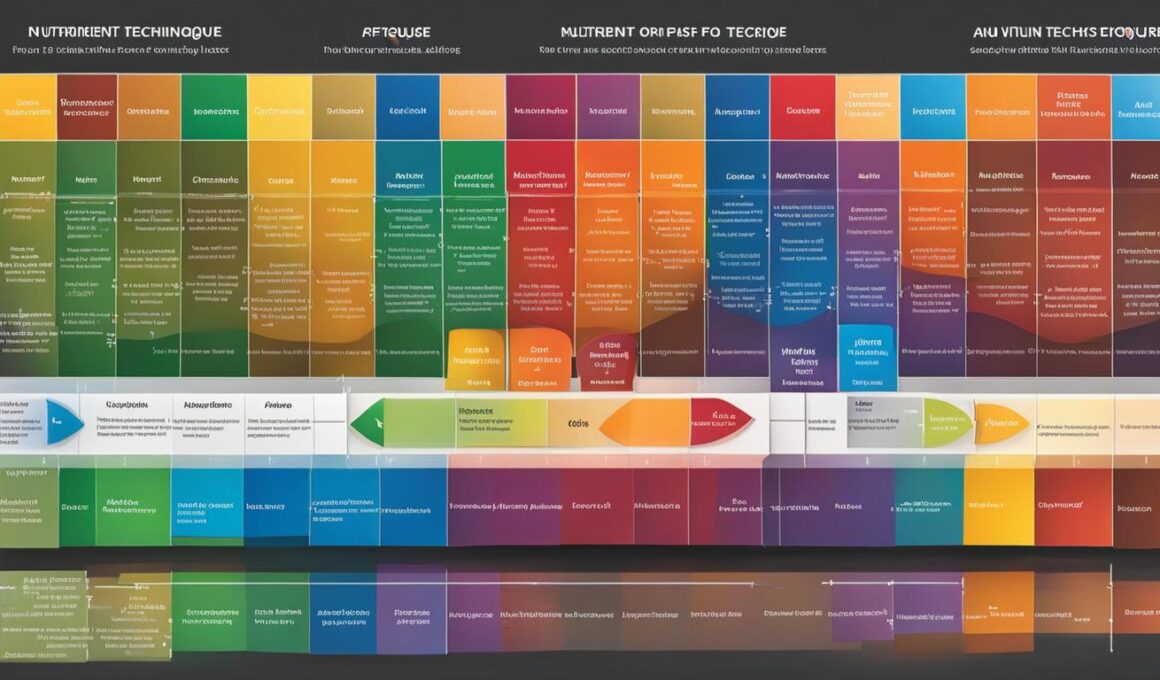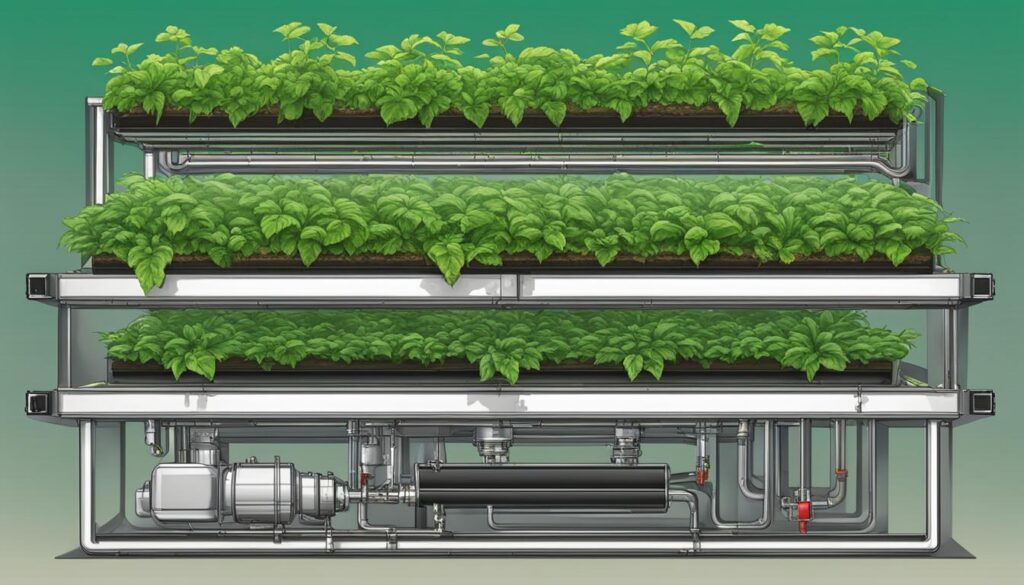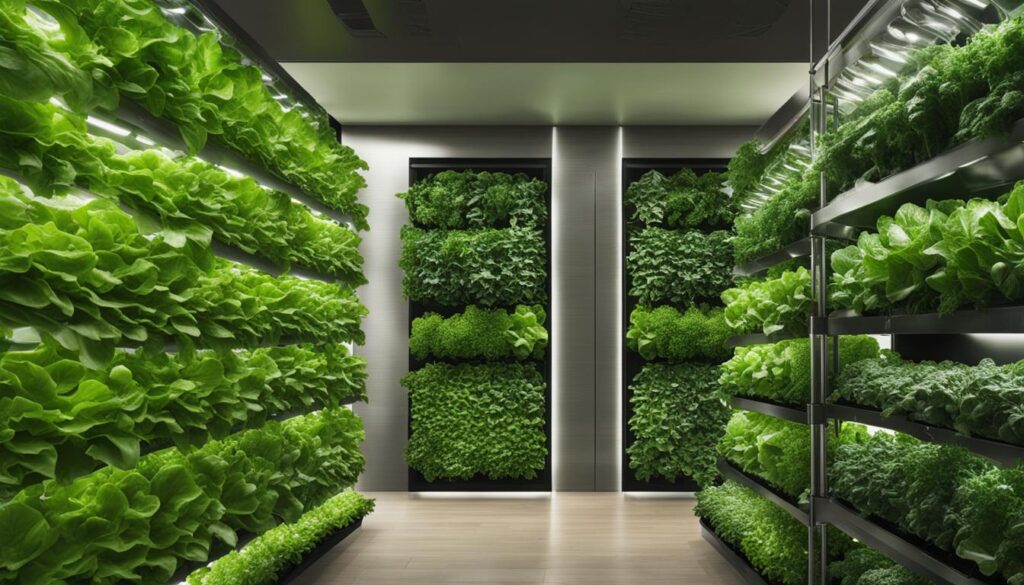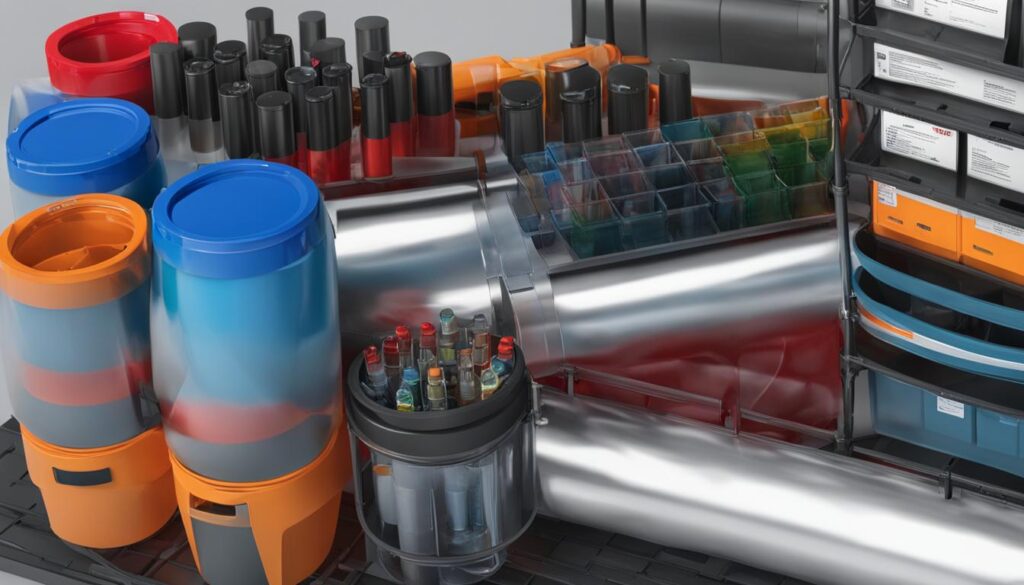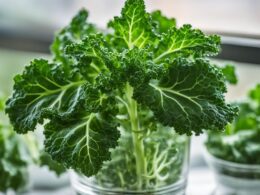The Nutrient Film Technique (NFT) system is a popular hydroponic system known for its simple yet effective design. It involves a shallow nutrient solution flowing over the roots of plants, allowing them to absorb nutrients. The NFT system is active and requires moving parts to work. It is best suited for growing lightweight, quick-growing plants like different types of lettuce.
Some advantages of the NFT system include low water and nutrient consumption, easy inspection of roots, and low environmental impact. However, it also has disadvantages such as the risk of root drying if the flow of nutrient solution stops and the inability to support heavy plants with large tap-root systems.
Post Summary
- The Nutrient Film Technique (NFT) system is a popular hydroponic system known for its simple design and effective nutrient delivery.
- Advantages of the NFT system include low water and nutrient consumption, easy inspection of roots, and a low environmental impact.
- Disadvantages of the NFT system include the risk of root drying, limited suitability for heavy plants, and the potential for pump failure.
- The NFT system is best suited for growing lightweight, quick-growing plants like different types of lettuce.
- Building an NFT system requires careful consideration of materials, channel length, and nutrient distribution.
What is the Nutrient Film Technique (NFT)?
The Nutrient Film Technique (NFT) is a hydroponic system where a shallow nutrient solution flows over the roots of plants. It is a continuous flow system that utilizes components such as a reservoir, nutrient pump, tubing, grow trays or channels, net pots, and a return system. The plants are placed in the grow trays or channels, allowing their roots to come into contact with the nutrient solution. The NFT system is similar to the Ebb and Flow technique in that they both use water pumps to deliver nutrients, but the NFT system has a constantly flowing water system.
One of the key aspects of the NFT system is the design of the grow trays or channels. They are set at a slight angle to allow the nutrient solution to flow down towards the nutrient return pipe. This controlled flow ensures that the plants’ roots are constantly supplied with a thin film of nutrient solution, allowing them to absorb the necessary nutrients. The constant flow also provides access to oxygen, giving the roots a well-oxygenated environment.
The design of the NFT system allows for efficient nutrient delivery to the plants while minimizing water and nutrient consumption. The continuous flow of the nutrient solution ensures that the plants have a steady supply of nutrients, promoting their growth and development.
Advantages of the Nutrient Film Technique (NFT)
The NFT system offers several advantages:
- Low water and nutrient consumption: The continuous flow of the nutrient solution in the NFT system requires less water and nutrients compared to other hydroponic systems.
- Easy inspection of roots: The shallow nutrient film allows for easy visual inspection of the roots, making it easier to identify any signs of disease or nutrient deficiencies.
- Low environmental impact: The NFT system minimizes the risk of contaminating groundwater due to its closed-loop system, making it an environmentally friendly option.
“The NFT system is known for its efficient nutrient delivery and the ability to grow a variety of lightweight, quick-growing plants.” – Expert Gardener
The Nutrient Film Technique (NFT) system offers a simple yet effective way to grow plants hydroponically. Its design allows for a continuous flow of nutrient solution over the roots, providing the necessary nutrients and oxygen to support plant growth. With its low water consumption, easy inspection of roots, and low environmental impact, the NFT system is a popular choice for growers looking for an efficient and cost-effective hydroponic system.
NFT System Mechanics and Operation
The Nutrient Film Technique (NFT) system operates on a simple yet effective principle. A pump delivers a continuous flow of water and nutrient solution from a reservoir to a slightly angled grow tray. The thin film of nutrient solution flows over the roots of the plants, allowing them to absorb the necessary nutrients. As the solution reaches the end of the tray, it is collected and recycled through the system, ensuring minimal waste and water consumption.
The operation of the NFT system relies on several key factors to ensure optimal nutrient delivery. The channel slope must be carefully controlled to allow proper flow and avoid stagnant areas that could lead to root drying. Additionally, the flow rate of the nutrient solution should be adjusted to maintain a steady film of water without causing excessive flooding.
How Does the Nutrient Film Technique Work?
The Nutrient Film Technique (NFT) system relies on the constant flow of a thin film of nutrient solution over the root system of plants. This technique offers several advantages, such as preventing waterlogging and providing access to oxygen. The plants’ roots hang down into the grow tray, absorbing the nutrients they need while ensuring they remain adequately hydrated. The constantly flowing water system in the NFT system helps maintain a favorable environment for the roots, promoting their growth and nutrient uptake.
To ensure the NFT system’s proper functioning, growers must pay attention to important mechanical aspects. The channel slope, flow rate, and channel length must all be carefully calibrated to optimize nutrient delivery. A well-designed NFT system allows for efficient water and nutrient use while providing the ideal conditions for plant growth.
| NFT System Mechanics and Operation | Description |
|---|---|
| Operation | Continuous flow of nutrient solution over roots |
| Key Factors | Controlled channel slope and flow rate |
| Advantages | Prevents waterlogging, access to oxygen |
| Mechanical Aspects | Channel slope, flow rate, and length |
Understanding the mechanics and operation of the Nutrient Film Technique (NFT) system is crucial for successful hydroponic gardening. By implementing proper channel design and flow control, growers can create an environment that promotes healthy root growth and efficient nutrient uptake. With its low water consumption and straightforward design, the NFT system offers a viable solution for cultivating lightweight, quick-growing plants.
Suitable Plants for the NFT System
The Nutrient Film Technique (NFT) system is well-suited for growing lightweight, fast-growing plants that do not require much support. Some suitable plants for the NFT system include:
- Lettuce: Different varieties of lettuce, such as butterhead, loose-leaf, and romaine, thrive in the NFT system due to their lightweight nature and relatively short growing cycle.
- Herbs: Culinary herbs like basil, parsley, and cilantro can be grown successfully in the NFT system. These herbs are known for their rapid growth and shallow root systems.
- Baby greens: Varieties of baby greens, including spinach, arugula, and kale, are well-suited for the NFT system. Their tender leaves and quick growth make them ideal candidates for this hydroponic method.
- Strawberries: Certain types of perennial plants like strawberries can thrive in the NFT system. These plants produce runners, allowing them to spread across the grow trays and produce a bountiful harvest.
It is important to note that the NFT system may not be suitable for growing plants with large tap-root systems or heavy crops that require substantial support. For example, plants like tomatoes or squash would need additional structural support in the form of a self-standing trellis system if grown in an NFT system.
When choosing plants for the NFT system, it is recommended to consider their growth habits, root systems, and water requirements. Selecting plants that align with the NFT system’s advantages can lead to a successful and productive hydroponic garden.
Benefits of Growing Suitable Plants in the NFT System
Growing suitable plants in the NFT system offers several benefits:
- Efficient use of water and nutrients: The NFT system’s shallow nutrient flow allows for effective and efficient nutrient absorption by the plants, reducing water and nutrient consumption.
- Easy inspection of roots: The design of the NFT system allows for easy access and observation of the plant roots, making it simpler to identify and address any issues such as diseases or nutrient deficiencies.
- Shorter growing cycles: Many of the suitable plants for the NFT system have relatively short growing cycles, allowing for faster harvests and increased productivity.
- Space-saving: The NFT system’s design minimizes the space required for growing plants, making it ideal for small spaces or indoor gardening.
By choosing the right plants for the NFT system, growers can maximize the benefits offered by this hydroponic method and enjoy a successful and rewarding gardening experience.
Materials Needed for an NFT System
To build an NFT system, you will need several components that work together to create an efficient and effective hydroponic setup. Here is a list of the materials you will need:
- Reservoir: A container to hold the nutrient solution. It can be made of plastic or other non-reactive materials to ensure the solution’s integrity.
- Nutrient Pump: This pump is responsible for delivering the nutrient solution from the reservoir to the grow tray or channel.
- Tubing: You will need tubing to distribute the nutrient solution from the pump to the growing tubes in the NFT system. PVC tubing is commonly used for this purpose.
- Grow Tray or Channel: This is where the plants will grow, and their roots will come into contact with the nutrient solution. The grow tray or channel can be made of various materials such as PVC pipe, plastic film, or round tubes.
- Net Pots: These pots hold the plants in place, allowing their roots to dangle into the nutrient solution.
- Return System: The return system guides the used nutrient solution back to the reservoir for recirculation.
Each component plays a crucial role in the functioning of the NFT system, and careful consideration should be given to their selection and installation.
| Component | Description |
|---|---|
| Reservoir | A container to hold the nutrient solution |
| Nutrient Pump | Delivers the nutrient solution from the reservoir |
| Tubing | Distributes the nutrient solution to the growing tubes |
| Grow Tray or Channel | Where the plants grow and roots come into contact with the nutrient solution |
| Net Pots | Holds the plants in place |
| Return System | Guides the used nutrient solution back to the reservoir |
Ensure you have all the necessary components before starting to build your NFT system. The choice of materials for the grow tray or channel can affect the even distribution of the nutrient solution to the roots. Pay attention to the quality of the materials to ensure the durability and longevity of your NFT system.
Advantages of the NFT System
The Nutrient Film Technique (NFT) system offers several advantages that make it a popular choice for hydroponic growers. Understanding the benefits of the NFT system can help you determine if it’s the right choice for your needs.
Low water and nutrient consumption
One of the key advantages of the NFT system is its efficient use of water and nutrients. The shallow film of nutrient solution flowing over the roots minimizes water waste, making it a cost-effective option. Additionally, the continuous flow of the nutrient solution ensures a consistent supply of nutrients to the plants, promoting healthy growth.
Easy inspection of roots
The design of the NFT system allows for easy inspection of the plant roots. Since the roots are exposed to the nutrient solution in a shallow film, it’s simple to visually assess their condition and check for any signs of disease or nutrient deficiencies. This enables timely intervention and adjustments to ensure optimal plant health.
“The NFT system offers low water and nutrient consumption, easy inspection of roots, and an environmentally friendly design.”
Low environmental impact
The NFT system has a low environmental impact compared to traditional soil-based farming. It minimizes the risk of contaminating groundwater with excess nutrients or chemicals, leading to a more sustainable and eco-friendly cultivation method. Additionally, by utilizing a recirculating system, the NFT system reduces water usage and maintains a closed-loop system.
| Advantages of the NFT System | Description |
|---|---|
| Low water and nutrient consumption | The NFT system efficiently utilizes water and nutrients, reducing waste and cost. |
| Easy inspection of roots | The design of the NFT system allows for visual inspection of the roots, enabling timely intervention. |
| Low environmental impact | The NFT system minimizes the risk of contaminating groundwater and reduces water usage. |
In summary, the NFT system offers advantages such as low water and nutrient consumption, easy inspection of roots, and an environmentally friendly design. These benefits make it an attractive option for hydroponic growers looking for efficient and sustainable cultivation methods.
Disadvantages of the NFT System
The Nutrient Film Technique (NFT) system, while offering several advantages, also has some drawbacks that growers should be aware of. One significant disadvantage is the risk of root drying if the flow of nutrient solution stops. Since the roots rely on a continuous flow of water to absorb nutrients, any interruption can quickly lead to the drying out of the roots and, ultimately, plant stress or death.
Another drawback of the NFT system is its limited suitability for certain plants. It is best suited for lightweight, fast-growing plants like lettuce, herbs, and baby greens. However, plants with large tap-root systems or heavy crops that require substantial support, such as tomatoes or squash, may not thrive in this system without additional support structures.
Pump failure is another concern in the NFT system, especially during hot weather. If the pump fails, the plants can suffer significant damage in a short amount of time. It is crucial to monitor the system regularly and have a backup plan in case of pump failure to minimize the risk of crop loss.
Quotes:
“The NFT system is efficient in terms of water and nutrient consumption, but it also requires careful management to prevent potential issues like root drying and pump failure. Growers need to choose suitable plants and ensure consistent monitoring to maximize the benefits of this hydroponic system.”
Despite these drawbacks, the NFT system remains a popular choice for growers due to its low water and nutrient consumption, easy root inspection, and minimal environmental impact. However, it is essential to carefully consider the limitations and challenges associated with this system before deciding to implement it on a larger scale.
| NFT System Disadvantages | Description |
|---|---|
| Root Drying | The risk of root drying if the flow of nutrient solution stops, leading to plant stress or death. |
| Limited Plant Suitability | Not suitable for plants with large tap-root systems or heavy crops that require significant support. |
| Pump Failure | Potential for significant crop damage in a short amount of time if the pump fails, especially in hot weather. |
Before implementing an NFT system, it is crucial to assess these disadvantages and determine if the system aligns with the specific needs and requirements of the intended crops. With proper planning and management, the NFT system can be a successful and efficient hydroponic solution.
Building an NFT System
Are you interested in setting up your own Nutrient Film Technique (NFT) system? Building an NFT system is a rewarding project that allows you to grow plants hydroponically with minimal water and nutrient consumption. Follow these steps to create your own NFT system and start growing your favorite crops:
Gather the Necessary Materials
To build an NFT system, you will need a few key components. These include a reservoir to hold the nutrient solution, a nutrient pump to deliver the solution, tubing to distribute water to the growing channels, a grow tray or channel for the plants, net pots to hold the plants, and a return system to guide the used nutrient solution back to the reservoir. Choose materials for the grow tray or channel based on your preference, such as PVC pipe, plastic film, or round tubes. The choice of materials can affect the even distribution of the nutrient solution to the roots, so choose wisely.
Design and Set up the NFT System
Once you have gathered all the necessary materials, it’s time to design and set up your NFT system. Determine the length and slope of the channels in your grow tray or channel to ensure proper nutrient delivery to all plants. Install the nutrient pump and connect the tubing to distribute the nutrient solution. Position the net pots in the grow tray or channel, and carefully place your chosen plants into the net pots. Make sure the plants’ roots are hanging down into the channel, allowing them to come into contact with the nutrient solution.
Ensure Proper Adjustments and Maintenance
After setting up your NFT system, it’s crucial to make the necessary adjustments and perform regular maintenance. Monitor the flow rate of the nutrient solution, ensuring it is providing a thin film of water over the roots without causing complete saturation. Adjust the slope of the channels if needed to optimize nutrient delivery. Regularly check the pump and tubing for any clogs or malfunctions. Flushing the system periodically and maintaining proper pH and nutrient levels will help ensure the health and productivity of your plants.
Building an NFT system requires attention to detail and proper adjustments to optimize plant growth. With the right materials, design, and maintenance, you can enjoy the benefits of an efficient and cost-effective hydroponic system. Get creative with your NFT system and start growing your favorite crops in a sustainable and controlled environment.
Conclusion
In conclusion, the Nutrient Film Technique (NFT) system offers a range of advantages and disadvantages for hydroponic growers. On the positive side, the NFT system boasts low water and nutrient consumption, making it an efficient and cost-effective option. It also allows for easy inspection of roots, enabling growers to identify any signs of disease or nutrient deficiencies swiftly. Additionally, the NFT system has a low environmental impact, reducing the risk of contaminating groundwater and promoting sustainable farming practices.
However, there are some drawbacks to consider. One potential issue is the risk of root drying if the flow of nutrient solution stops. This can lead to plant stress and hamper overall growth. The NFT system is also not suitable for plants with large tap-root systems or heavy crops that require substantial support. Additionally, there is the possibility of pump failure, which can cause significant crop damage, especially in hot weather conditions.
Despite these challenges, the NFT system remains a popular choice among growers due to its efficiency and cost-effectiveness. When building an NFT system, it is crucial to pay attention to materials, channel length, and nutrient distribution to optimize plant growth. By carefully considering these factors, hydroponic enthusiasts can harness the benefits of the NFT system and create a successful growing environment for various lightweight and quick-growing plants.
What are the advantages and disadvantages of using the Ebb and Flow system compared to the Nutrient Film Technique?
When doing an ebb and flow system review, it’s important to consider its advantages and disadvantages compared to the Nutrient Film Technique. The ebb and flow system allows for better aeration of the roots and easier customization, but it can be more prone to flooding and requires more maintenance than the Nutrient Film Technique.
FAQ
What are the advantages of the Nutrient Film Technique (NFT) system?
The NFT system offers low water and nutrient consumption, easy inspection of roots, and an environmentally friendly design.
What are the disadvantages of the Nutrient Film Technique (NFT) system?
The NFT system has the risk of root drying, limited suitability for certain plants, and the potential for pump failure.
What is the Nutrient Film Technique (NFT)?
The NFT system is a hydroponic system where a shallow nutrient solution flows over the roots of plants.
How does the Nutrient Film Technique work?
The NFT system uses a pump to deliver water and nutrients to the grow tray, allowing the roots to absorb them from the flowing water.
Which plants are suitable for the NFT system?
Lightweight, fast-growing plants like lettuce, herbs, baby greens, and some perennial plants like strawberries are suitable for the NFT system.
What materials are needed for an NFT system?
You will need components such as a reservoir, nutrient pump, tubing, grow tray or channel, net pots, and a return system.
What are the advantages of the NFT system?
The NFT system offers low water and nutrient consumption, easy inspection of roots, and an environmentally friendly design.
What are the disadvantages of the NFT system?
The NFT system has the risk of root drying, limited suitability for certain plants, and the potential for pump failure.
How do you build an NFT system?
Building an NFT system involves setting up a reservoir, choosing a grow tray or channel material, installing a nutrient pump and tubing, and ensuring a proper return system.
What are the advantages of the Nutrient Film Technique (NFT) system?
The NFT system offers low water and nutrient consumption, easy inspection of roots, and an environmentally friendly design.





